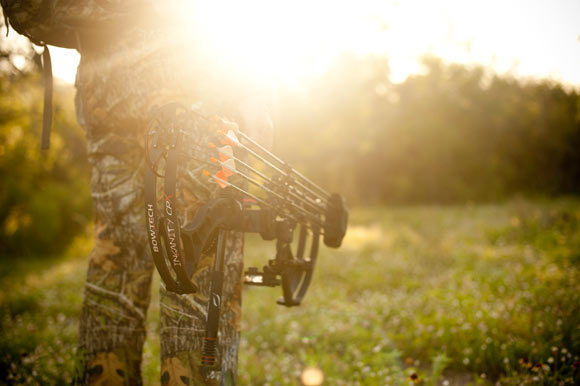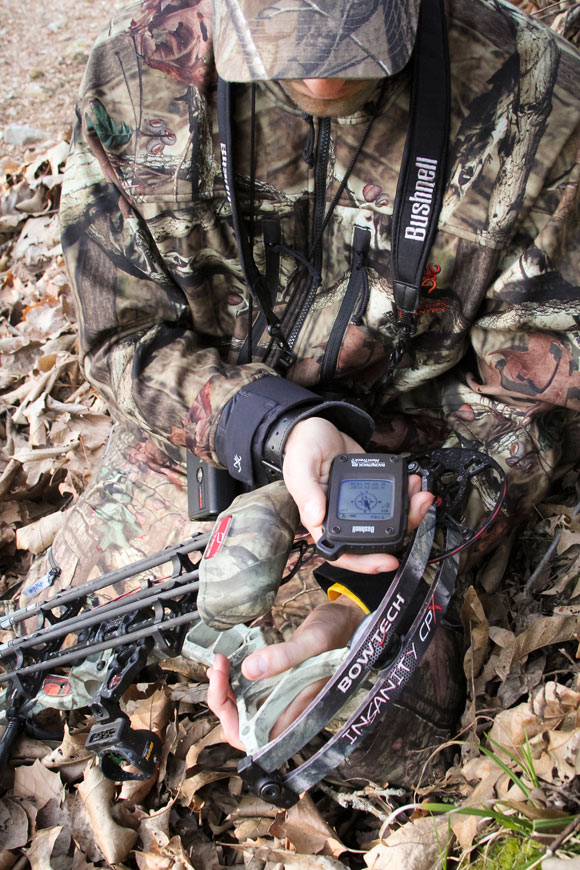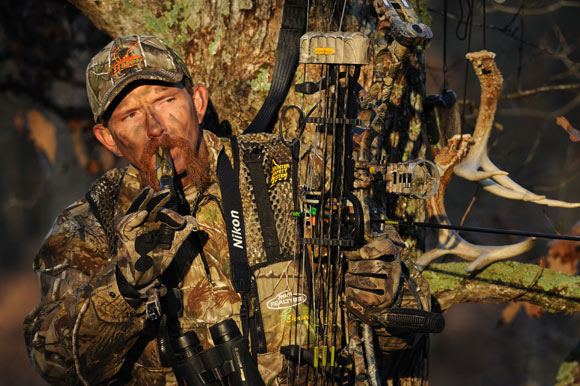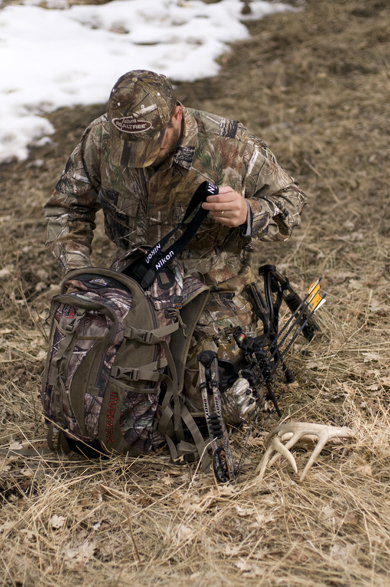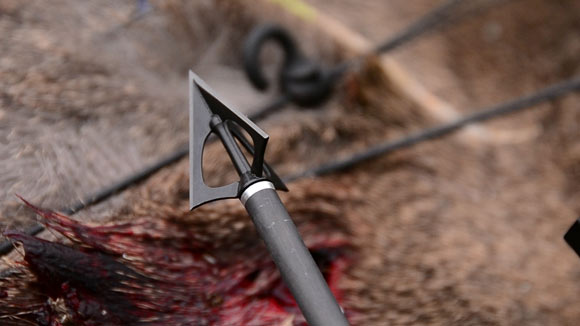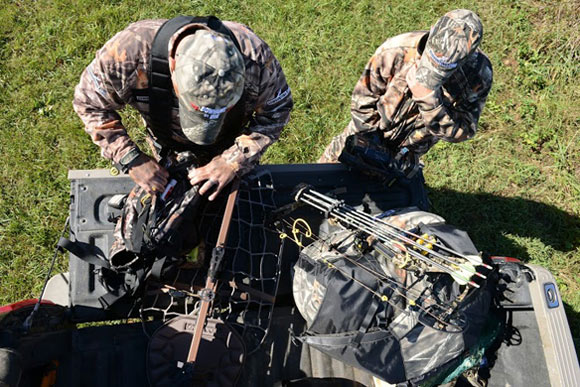LAST UPDATED: May 1st, 2015
I recall when bowhunting involved only a bow and arrows and a few items tucked into my fatigue pockets. Today, of course, even quick morning tree-stand visuals before work require fully-loaded daypacks. Today we have a lot of gear to tote most of it actually useful in way of making us more efficient bowhunters. Granted half this toted gear sees little action, but it’s there, just in case. Also, for those whose time’s limited (making the best of the hours before or after work and limited weekend freedom) having a carefully-stocked pack ready for action saves time. The question then begs asking; what should I pack, aside from essential safety gear and pull-up rope, of course?
Comings and Goings
Savvy whitetail hunters climb into stands well before shooting hours or don’t leave until the final sweep of the second hand signaling day’s end. This means walking in and out of stands in shadowy conditions. Don’t be a tough guy and risk injury falling in the dark without a flashlight. I prefer multi-setting headlamps with full (for trailing or traversing treacherous terrain) and dim settings, plus red-lens option for approaching dark stands without spooking nearby game. Headlamps hold the advantage of leaving hands free to push aside brush in thick areas or field dressing game.
While finding a stand site in the daylight might be easy, finding it in the dark is another matter. Make sure you have a plan for finding your stand before your head out in the early morning darkness.
Some stands are easy to find. Some are not. Many of my big-woods stands require some bushwhacking to access. Too, even in limited woodlots the stand you hung in broad daylight just might not be so easy to find again when it’s dark. A GPS, surveying tape and reflective tacks are all worthwhile additions to any hunting pack – marking access trails and stands to assure no wasted time or additional scent distribution while wandering to hone in on the site. There’s nothing more frustrating than wandering dark woods shining a flashlight into treetops, convinced you’re clearing the woods of deer in the process…
The Hunt
Every whitetail hunt starts with scent prevention. Scent-killer spray’s a big part of this. I believe in scent-suppressing products enough that I always carry a bottle in my hunting pack, spraying down before leaving the truck, giving boots and pants cuffs an extra dousing 100 yards out to assure I leave minimal human scent at stand sites. I buy smaller bottles of product for my pack, using larger refill bottles to replenish this between hunts.
GPS units are also great for finding your way through the darkness of morning or finding your way back to civilization after tracking a buck at last light.
Many bowhunters fail to understand deer calling’s a season-long affair. During pre-rut, with breeding activities weeks away, aggressive rattling, grunting and doe estrous calls obviously aren’t part of the program, but quiet social calls certainly are. Fawn bleat calls are a perfect vehicle for filling early-season doe tags. Subtle doe and buck contact grunts or bleats can bring both early-season does and bucks beneath your stands. Too, pre-rut’s the best time to engage in “antler tickling,” imitating bachelor bucks sparing gently while establishing pecking orders without all-out battles. Compact rattle bags or Knight & Hale’s Pack-Rack make perfect options for such ploys. Curious bucks often swing into range to investigate these calls (they also work wonders during the rut in lesser habitat with less-than-ideal herd dynamics, by the way).
The right call at the right time will work wonders….but only if it is in your backpack.
When I shot fingers exclusively I didn’t shoot well without a well broken-in tab. In recent years, adopting release aids with more frequency, shooting without release is out of the question. Ever arrived at a stand without your release? Not a good feeling. More common for me (since I shoot T-handles) is to accidently drop my release from the tree after getting situated. No matter. I ALWAYS carry a spare release in my hunting pack. Like four-wheel drive, it’s expensive and seemingly superfluous – until you need it badly.
Even during early pre-rut dates I carry a couple precautionary clothing items in my hunting pack – no matter what the weatherman has predicted. One of these is a warm stocking or fleece hat. You just never know when a cool breeze or fog might ask for this extra bit of heat retention – meaning the difference between getting the chills and total comfort. A stocking cap takes up little space and can be used to pad valuables such as cameras when not in use. I always carry rain gear. It, obviously, keeps me dry during unexpected thunderstorms, acts as a wind-cutting extra layer when driving an ATV after an evening hunt or when a sudden front causes temperatures to dip. Today’s lightweight, packable raingear occupies little pack space but offers big insurance against unforeseen weather. Though stand hunting normally involves short range and tight quarters, I still carry optics – an 8×32 binocular for viewing passing game, and laser rangefinder to tell me the range around my stand.
When nasty weather hits it is nice to know that everything you need to stay dry, warm and comfortable is at your fingertips.
Success
We all take to the field each and every time dreaming of bowhunting success, but are you actually prepared in case your dream comes true? At the bare minimum this means having a knife and sharpening steel on hand. And I mean a shaving-sharp knife ready for action, not the dull, chip-edged blade you carry in your pocket to open boxes and scrape crud off truck battery terminals… At bare minimum you will be field dressing a meat doe or management buck to lighten the load while dragging it to a handy pickup site. In still other areas field dressing means complete skinning and quartering until a backpack or ATV can be retrieved to haul meat out of a difficult place. In this case a compact, folding bone saw is not a bad idea either, which also doubles for cutting troublesome branches preventing a clean shot from your tree-stand.
Once your trophy is down the real work begins. Do you have everything you need in your pack to get the job done?
If deer can be easily dragged to a field edge or road for vehicle pickup, remember to toss your haul strap into your pack. Safety vests from Hunter Safety Systems, for instance, come with a complimentary haul strap, which clips into the rear of the four-point harness and allows using your shoulders to pull heavy loads. In still other areas – and especially if you’re one of those hunters who regularly puts in stand time early mornings before work — a bagged deer can cause a scheduling pinch. In my college days I found myself in this predicament regularly, requiring I leave deer in the field to be retrieved later to avoid being late for classes. Rope and some compact game bags allowed me to skin deer on the spot, hang them in a cool spot out of reach of dogs or predators and wrap them in a game bag to detour blowflies. And don’t forget the memories. Today’s point-and-shoot digital cameras, with use of self-timer and compact tripod, allow taking kill shots in the field, on your own. In this case it also pays to have some paper towels (or toilet paper, which serves many purposes…) and water bottle to clean away excess blood before shooting.
Hunting time is precious in the hectic times we live in. An organized pack means less time organizing gear and more time on stand hunting.
Of course the modern bowhunter never leaves home without proper licenses and landowner trespass-permission note to avoid game-warden hassle, and a charged cell phone in case help must be summoned after an accident or successful hunt. Finally, rounding out my stand-hunting pack is a pee bottle, hydration and lunch or snacks so there is no excuse to abandon my stand early, keeping me in the game longer.

 By
By 